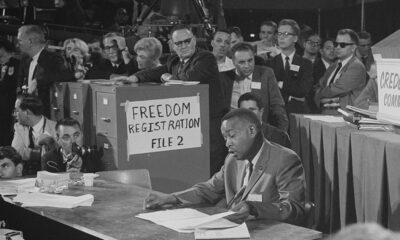Mississippi Today
Special interest groups endorse, donate to Mississippi judicial candidates

Special interest groups have donated at least $117,000 to candidates running in contested elections for the Mississippi Supreme Court and the Mississippi Court of Appeals so far this year, and that figure is almost certain to increase before the November election.
Judicial elections in Mississippi are typically low-interest races where law firms, individual lawyers and trade associations make up the lion’s share of political contributions. Endorsements from special interest groups often give candidates an edge in the race and their donations often give candidates a needed boost in campaigning.
The candidate who has racked up the most money from trade associations and other interest groups, according to campaign finance documents Mississippi Today reviewed, is Republican state Sen. Jennifer Branning of Philadelphia who is challenging incumbent Justice Jim Kitchens for his central district Supreme Court seat.
Branning has received at least $84,500 from interest groups, including $5,000 from the Mississippi Realtors PAC, $5,000 from the Mississippi Bankers Association and $5,000 from the Mississippi Road Builders PAC.
The candidate who has received the second-highest number of donations from special interest groups is incumbent Supreme Court Justice Dawn Beam of the southern district who is facing a challenge from Coast-based lawyer David Sullivan.
Beam has received at least $27,500 from special interest groups including $5,000 from the Mississippi Physicians PAC and $5,000 from the Mississippi Medical PAC.
With the election still four months away, these types of donations are widely expected to increase.
Brandon Jones, the director of campaigns for the Southern Poverty Law Center’s Action Fund, an organization that promotes racial justice, said on Mississippi Today’s July 15 edition of “The Other Side” political podcast, that the organization is endorsing Kitchens’ bid for reelection, though he did not say whether that endorsement would come with a donation.
“Kitchens was elected in 2009 and has been, what I believe, one of the fairest, honest, down-the-middle and just kind of within the mainstream of what we would hope out of a jurist,” Jones said.
It’s fairly common in the Magnolia State for political organizations and interests groups to get involved in judicial races, since Mississippi opts to elect its state judges. But candidates for the state’s most powerful judicial roles are limited in how they can campaign and fundraise.
The Code of Judicial Conduct adopted by the Mississippi Supreme Court prohibits judicial candidates from commenting on how they would rule on a potential case that could come before them.
And the code technically bans candidates from directly raising money, but they commonly get around this prohibition by forming a campaign committee to raise and spend money.
Since candidates for the most powerful judicial offices in the state can’t comment on how they’ll rule on cases, why do special interest groups donate to these candidates at all?
The Mississippi Physicians PAC, an arm of the medical malpractice insurance organization Medical Assurance of Mississippi, has donated $15,000 to three judicial candidates this year. The organization did not return a request for comment on why it had invested so much money in judicial races this year.
The Mississippi Medical PAC, operated by the powerful Mississippi State Medical Association, has collectively donated $10,000 to judicial candidates so far this cycle.
Dr. Jim Rish, past president of the organization and current chairman of the PAC, told Mississippi Today that the organization looks to the judicial candidates’ prior rulings and personal judicial philosophy to determine donations.
Rish said the organization’s primary concern is protecting the hard-fought battles it helped achieve on “tort reform” in 2004 or changes to state law that reduced the amount of damages plaintiffs can receive from malpractice litigation.
Mississippi by the early 2000s had become known as a lawsuit haven, where sympathetic juries and judges handed out huge awards to plaintiffs who filed malpractice suits against physicians and hospitals.
Medical leaders at the time argued they were on the verge of shuttering clinics because the cost of malpractice insurance had skyrocketed.
As a result, medical, insurance, business and political forces joined to push for lawsuit reform. The coalition proved successful when Gov. Haley Barbour and the state Legislature in 2004 passed legislation to cap noneconomic and punitive damages for such suits.
“We don’t intend to become complicit in allowing the environment to revert back to that,” Rish said. “We’re fully engaged, and that’s why we take a keen interest in these races.”
The Mississippi Association of Realtors and the Mississippi Poultry Association have also each donated $10,000 so far in the ongoing judicial campaigns. None of the organizations returned a request for comment.
Judicial offices are nonpartisan, so candidates do not participate in a party primary. All candidates will appear on the Nov. 5, 2024, general election ballot. If a candidate does not receive a majority of the votes cast, the two candidates who received the most votes will advance to a runoff election on Nov. 26.
Judges on Mississippi’s two highest courts do not run at large. Instead, voters from their respective districts elect them.
The nine members of the Supreme Court are elected from three districts: northern, central and southern. The 10 members of the Court of Appeals are each elected from five districts across the state.
The judges are elected in staggered terms, so all 19 seats of the two courts are not up for election each cycle.
For the Supreme Court, the chief justice is chosen by
This article first appeared on Mississippi Today and is republished here under a Creative Commons license.![]()
Mississippi Today
1964: Mississippi Freedom Democratic Party was formed
April 26, 1964

Civil rights activists started the Mississippi Freedom Democratic Party to challenge the state’s all-white regular delegation to the Democratic National Convention.
The regulars had already adopted this resolution: “We oppose, condemn and deplore the Civil Rights Act of 1964 … We believe in separation of the races in all phases of our society. It is our belief that the separation of the races is necessary for the peace and tranquility of all the people of Mississippi, and the continuing good relationship which has existed over the years.”
In reality, Black Mississippians had been victims of intimidation, harassment and violence for daring to try and vote as well as laws passed to disenfranchise them. As a result, by 1964, only 6% of Black Mississippians were permitted to vote. A year earlier, activists had run a mock election in which thousands of Black Mississippians showed they would vote if given an opportunity.
In August 1964, the Freedom Party decided to challenge the all-white delegation, saying they had been illegally elected in a segregated process and had no intention of supporting President Lyndon B. Johnson in the November election.
The prediction proved true, with white Mississippi Democrats overwhelmingly supporting Republican candidate Barry Goldwater, who opposed the Civil Rights Act. While the activists fell short of replacing the regulars, their courageous stand led to changes in both parties.
This article first appeared on Mississippi Today and is republished here under a Creative Commons Attribution-NoDerivatives 4.0 International License.![]()
Mississippi Today
Mississippi River flooding Vicksburg, expected to crest on Monday
Warren County Emergency Management Director John Elfer said Friday floodwaters from the Mississippi River, which have reached homes in and around Vicksburg, will likely persist until early May. Elfer estimated there areabout 15 to 20 roads underwater in the area.
“We’re about half a foot (on the river gauge) from a major flood,” he said. “But we don’t think it’s going to be like in 2011, so we can kind of manage this.”
The National Weather projects the river to crest at 49.5 feet on Monday, making it the highest peak at the Vicksburg gauge since 2020. Elfer said some residents in north Vicksburg — including at the Ford Subdivision as well as near Chickasaw Road and Hutson Street — are having to take boats to get home, adding that those who live on the unprotected side of the levee are generally prepared for flooding.



“There are a few (inundated homes), but we’ve mitigated a lot of them,” he said. “Some of the structures have been torn down or raised. There are a few people that still live on the wet side of the levee, but they kind of know what to expect. So we’re not too concerned with that.”
The river first reached flood stage in the city — 43 feet — on April 14. State officials closed Highway 465, which connects the Eagle Lake community just north of Vicksburg to Highway 61, last Friday.

Elfer said the areas impacted are mostly residential and he didn’t believe any businesses have been affected, emphasizing that downtown Vicksburg is still safe for visitors. He said Warren County has worked with the U.S. Army Corps of Engineers and the Mississippi Emergency Management Agency to secure pumps and barriers.
“Everybody thus far has been very cooperative,” he said. “We continue to tell people stay out of the flood areas, don’t drive around barricades and don’t drive around road close signs. Not only is it illegal, it’s dangerous.”
NWS projects the river to stay at flood stage in Vicksburg until May 6. The river reached its record crest of 57.1 feet in 2011.




This article first appeared on Mississippi Today and is republished here under a Creative Commons Attribution-NoDerivatives 4.0 International License.![]()
Mississippi Today
With domestic violence law, victims ‘will be a number with a purpose,’ mother says
Joslin Napier. Carlos Collins. Bailey Mae Reed.
They are among Mississippi domestic violence homicide victims whose family members carried their photos as the governor signed a bill that will establish a board to study such deaths and how to prevent them.
Tara Gandy, who lost her daughter Napier in Waynesboro in 2022, said it’s a moment she plans to tell her 5-year-old grandson about when he is old enough. Napier’s presence, in spirit, at the bill signing can be another way for her grandson to feel proud of his mother.
“(The board) will allow for my daughter and those who have already lost their lives to domestic violence … to no longer be just a number,” Gandy said. “They will be a number with a purpose.”
Family members at the April 15 private bill signing included Ashla Hudson, whose son Collins, died last year in Jackson. Grandparents Mary and Charles Reed and brother Colby Kernell attended the event in honor of Bailey Mae Reed, who died in Oxford in 2023.
Joining them were staff and board members from the Mississippi Coalition Against Domestic Violence, the statewide group that supports shelters and advocated for the passage of Senate Bill 2886 to form a Domestic Violence Facility Review Board.
The law will go into effect July 1, and the coalition hopes to partner with elected officials who will make recommendations for members to serve on the board. The coalition wants to see appointees who have frontline experience with domestic violence survivors, said Luis Montgomery, public policy specialist for the coalition.
A spokesperson from Gov. Tate Reeves’ office did not respond to a request for comment Friday.
Establishment of the board would make Mississippi the 45th state to review domestic violence fatalities.
Montgomery has worked on passing a review board bill since December 2023. After an unsuccessful effort in 2024, the coalition worked to build support and educate people about the need for such a board.
In the recent legislative session, there were House and Senate versions of the bill that unanimously passed their respective chambers. Authors of the bills are from both political parties.
The review board is tasked with reviewing a variety of documents to learn about the lead up and circumstances in which people died in domestic violence-related fatalities, near fatalities and suicides – records that can include police records, court documents, medical records and more.
From each review, trends will emerge and that information can be used for the board to make recommendations to lawmakers about how to prevent domestic violence deaths.
“This is coming at a really great time because we can really get proactive,” Montgomery said.
Without a board and data collection, advocates say it is difficult to know how many people have died or been injured in domestic-violence related incidents.
A Mississippi Today analysis found at least 300 people, including victims, abusers and collateral victims, died from domestic violence between 2020 and 2024. That analysis came from reviewing local news stories, the Gun Violence Archive, the National Gun Violence Memorial, law enforcement reports and court documents.
Some recent cases the board could review are the deaths of Collins, Napier and Reed.
In court records, prosecutors wrote that Napier, 24, faced increased violence after ending a relationship with Chance Fabian Jones. She took action, including purchasing a firearm and filing for a protective order against Jones.
Jones’s trial is set for May 12 in Wayne County. His indictment for capital murder came on the first anniversary of her death, according to court records.
Collins, 25, worked as a nurse and was from Yazoo City. His ex-boyfriend Marcus Johnson has been indicted for capital murder and shooting into Collins’ apartment. Family members say Collins had filed several restraining orders against Johnson.
Johnson was denied bond and remains in jail. His trial is scheduled for July 28 in Hinds County.
He was a Jackson police officer for eight months in 2013. Johnson was separated from the department pending disciplinary action leading up to immediate termination, but he resigned before he was fired, Jackson police confirmed to local media.
Reed, 21, was born and raised in Michigan and moved to Water Valley to live with her grandparents and help care for her cousin, according to her obituary.
Kylan Jacques Phillips was charged with first degree murder for beating Reed, according to court records. In February, the court ordered him to undergo a mental evaluation to determine if he is competent to stand trial, according to court documents.
At the bill signing, Gandy said it was bittersweet and an honor to meet the families of other domestic violence homicide victims.
“We were there knowing we are not alone, we can travel this road together and hopefully find ways to prevent and bring more awareness about domestic violence,” she said.
This article first appeared on Mississippi Today and is republished here under a Creative Commons Attribution-NoDerivatives 4.0 International License.
-

 News from the South - Florida News Feed7 days ago
News from the South - Florida News Feed7 days agoJim talks with Rep. Robert Andrade about his investigation into the Hope Florida Foundation
-

 News from the South - Alabama News Feed5 days ago
News from the South - Alabama News Feed5 days agoPrayer Vigil Held for Ronald Dumas Jr., Family Continues to Pray for His Return | April 21, 2025 | N
-

 Mississippi Today6 days ago
Mississippi Today6 days ago‘Trainwreck on the horizon’: The costly pains of Mississippi’s small water and sewer systems
-

 News from the South - Florida News Feed5 days ago
News from the South - Florida News Feed5 days agoTrump touts manufacturing while undercutting state efforts to help factories
-

 News from the South - Texas News Feed6 days ago
News from the South - Texas News Feed6 days agoMeteorologist Chita Craft is tracking a Severe Thunderstorm Warning that's in effect now
-

 News from the South - Arkansas News Feed7 days ago
News from the South - Arkansas News Feed7 days agoAs country grows more polarized, America needs unity, the ‘Oklahoma Standard,’ Bill Clinton says
-

 News from the South - Missouri News Feed22 hours ago
News from the South - Missouri News Feed22 hours agoMissouri lawmakers on the cusp of legalizing housing discrimination
-

 News from the South - Virginia News Feed6 days ago
News from the South - Virginia News Feed6 days agoTaking video of military bases using drones could be outlawed | Virginia
















































